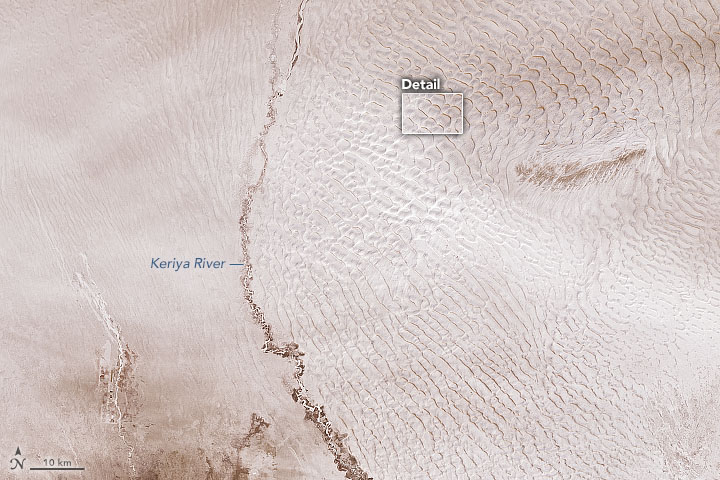


Today’s Image of the Day is the answer to the January 2023 puzzler.
Flanked by mountain ranges on three sides and parched by the resulting rain shadow, the Tarim Basin in the Xinjiang region of western China typically receives little or no snow in winter. But after a storm in January 2023, the southwestern portion of the basin looked more like the snow-covered peaks that surround it.
A powerful winter storm that passed through central Asia dumped a blanket of snow on the region between January 12 and January 14. The images at the top of the page show detailed and wide views of snow-covered desert landscapes and sand dunes near the Keriya River. The images were acquired by the Operational Land Imager-2 (OLI-2) on Landsat 9 on January 19, 2023, after storm clouds had cleared. The Visible Infrared Imaging Radiometer Suite (VIIRS) on the NOAA-NASA Suomi NPP satellite captured a wider image (below) of the snow-covered landscape in southern Xinjiang on the same day. In this false-color image, snow appears blue.
Though rare, similar snow events have happened in parts of the Taklamakan Desert in 2021, 2013, and 2008. Teams of researchers are using satellites and meteorological data from weather stations on the ground to track whether the amount of snow falling in the Taklamakan Desert is changing over time. One study authored by Xinjiang University researchers reported a trend toward higher temperatures and more precipitation in the Tarim Basin between 1961 and 2019, including both rain and snow.
Snow and ice-covered dunes are not unique to Earth. They can also be found tens of millions of miles away on Mars. The image below shows a group of crescent-shaped barchan dunes with a layer of carbon dioxide frost and ice that built up over the winter. The High Resolution Imaging Science Experiment (HiRISE) instrument aboard NASA’s Mars Reconnaissance Orbiter acquired the image of the dunes in the north polar region of Mars on July 28, 2021.
Unlike water ice on Earth, carbon dioxide ice (also known as dry ice) on Mars undergoes sublimation, meaning it turns directly into a vapor rather than a liquid when warmed. The white areas in the image are covered with ice and frost; darker areas are places where spring warming and sublimation exposed parts of the dune surface. By the Martian summer, all the ice in the area was gone.
Carbon dioxide frost and ice require temperatures below -190°F (-78°C), so it only forms in certain areas with extremely cold conditions: at the poles, under cloud cover, and at night. The average temperature of the Martian surface is -85°F (-65°C), though temperatures can rise into the 70s (Fahrenheit) in the lower latitudes during the summer.
Though the Martian atmosphere is quite dry and thin, carbon dioxide snowfall does occur, mostly over flat areas and typically with only minimal accumulation. “Enough falls that you could snowshoe across it,” said Sylvain Piqueux, a planetary scientist at NASA’s Jet Propulsion Laboratory. “If you were looking for skiing, though, you’d have to go into a crater or cliffside, where snow could build up on a sloped surface.”
See more wintry scenes of Earth taken from the International Space Station and of Mars taken by orbiting satellites.NASA Earth Observatory images by Joshua Stevens, using Landsat data from the U.S. Geological Survey and VIIRS data from NASA EOSDIS LANCE, GIBS/Worldview, and the Suomi National Polar-orbiting Partnership. Mars HiRISE imagery courtesy of NASA/JPL-Caltech/University of Arizona. Story by Adam Voiland.